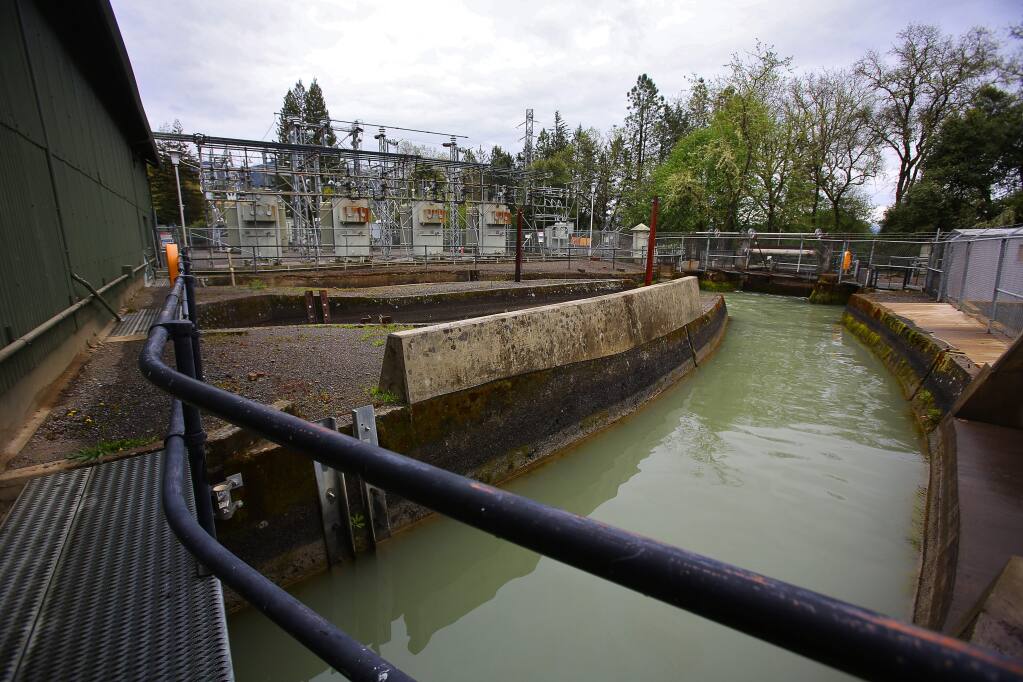
MARY CALLAHAN
THE PRESS DEMOCRAT, February 1, 2022, 6:45PM
Plans to acquire an aging power plant in Mendocino County to ensure continued flows of Eel River water into Lake Mendocino and Sonoma County have unraveled.
A coalition of organizations from Sonoma, Humboldt and Mendocino counties abandoned their quest to acquire the century-old Potter Valley hydroelectric plant, saying it could not meet an April 14 deadline for submitting a federal license application.
The plant, about 80 miles north of Santa Rosa, is owned by Pacific Gas & Electric, which in 2019 announced plans to abandon it and surrender its license.
Water users downstream maintained the plant was critical because Eel River water is diverted through its turbines into Lake Mendocino and the Russian River. That, in turn, supplies users as far south as Sonoma and northern Marin counties.
Without the option of acquiring the plant, stakeholders predict years of uncertainty, quarreling and, ultimately, higher costs to water users.
“Nobody has a slam dunk here,” Rep. Jared Huffman said Tuesday. “Everybody’s at risk.”
Huffman, D-San Rafael, was largely responsible for bringing together the coalition known as Two-Basin Solution Partnership with the aim of acquiring the Potter Valley project license.
Members included the Sonoma County Water Agency, the Mendocino County Inland Water and Power Commission, the Round Valley Indian Tribes, Cal Trout and Humboldt County Public Works.
Their goal was two-pronged: The first was to secure continued transmission of water from the Eel River, some of which has been funneled historically through the power plant’s turbines to generate electricity. The second goal was to pursue removal of Scott Dam, a seismically vulnerable, 138-foot concrete structure that blocks the upstream passage of federally protected salmon and steelhead trout.
The application effort derailed, in part, because funding from PG&E for at least $18 million in planning and studies was not forthcoming, and the partners had yet to form a regional entity to be the formal licensee.
The coalition asked the Federal Energy Regulatory Commission, or FERC, for more time last fall to prepare its case, but the agency denied the request.
The result appears to put an end to discussion about acquiring and re-licensing the power plant, which all agree is inefficient and, at the moment, inoperable due to a failed transformer bank.
It also means the partners can focus ensuring water diversions and dam removal become part of PG&E’s license surrender and plant decommissioning process, officials said.
But “this is not going to be easy,” said Pam Jeane, assistant general manager for Sonoma Water, the dominant drinking water wholesaler in the region.
PG&E, whose license expires in mid-April, will be granted annual extensions while the surrender process unfolds ― which could take years or even a decade or more.
The latest developments will likely set up battles between competing interests, such as environmentalists and agriculture, to ensure final decommissioning orders include provisions they care about. Those could include water rights and dam removal.
Huffman noted that the only thing PG&E has of value out of the whole deal are rights to the water, so they’re not likely to part with them cheaply.
But PG&E will be allowed to propose its own vision of what decommissioning should look like first, and federal regulators will make the final decision.
It’s a process, said Jeane, “that could range from putting a padlock on the gate and walking away to removing every single piece of concrete out there.”
That includes Scott Dam, which impounds Lake Pillsbury in Lake County, and even smaller, Cape Horn Dam, which forms a small reservoir at the entry of a mile-plus-long tunnel leading to Potter Valley and the power plant.
Cape Horn is equipped with a fish ladder many deem inadequate to aid the fish that use it, with features that actually make them vulnerable to predators.
Those who advocate removing Scott Dam and even Cape Horn Dam say a study released in December by the National Marine Fisheries Service offers leverage for persuading FERC to require dam removal.
The study considered conditions in the upper reaches of the Eel River, California’s third largest salmon and steelhead trout watershed behind Klamath/Trinity and the Sacramento/San Joaquin Basins. It identified plentiful suitable habitat for winter- and summer-run steelhead trout, and fall-run Chinook salmon.
In addition, said Alicia Hamann, executive director of Friends of the Eel River, conditions in the power plant license that allow for incidental loss of fish listed under the Endangered Species Act leave PG&E vulnerable to litigation if they no longer hold the license and fish remain imperiled due to the dams.
“We have science on our side, and really what it comes down to is there’s a strong legal argument to be made that the project owners have a responsibility to correct the century of harms that have been done to the Eel River,” Hamann said. “The Eel is a river of opportunity. It’s our last, best chance to protect wild salmon and steelhead in the entire state of California.”
There also remained the “wild cards” of Lake County, the Lake Pillsbury Homeowners’ Association and allies who will likely fight to preserve the recreational asset created by Scott Dam, Huffman said.
In addition, there is extensive work needed to educate and organize Russian River water users about the high-stakes campaign ahead to ensure water keeps flowing from the Eel River.
A nearly $2 million grant acquired in December from the California Department of Water Resources will aid that effort. Part of the money will go toward a “Russian River Water Users Forum” to help determine who benefits, who should pay, and how much, Jeane said.
But the bottom line, is there are no guarantees, Huffman said.
“Yes, the water supply is absolutely at risk, both from an infrastructure and a water rights perspective, and the Russian River interests are going to have to focus on that,” Huffman said. “On the Eel River side, I think there’s a very good chance that PG&E is required to remove at least Scott Dam, but how that happens, you know, and what other mitigation requirements are imposed ― what it means in terms of a healthy Eel River ― I just think there’s huge question marks, and whether it turns out being something that’s fought and litigated for decades to come.
“So nobody has a slam dunk scenario to get everything they want here,” he said.
You can reach Staff Writer Mary Callahan at 707-521-5249 or mary.callahan@pressdemocrat.com. On Twitter @MaryCallahanB.

